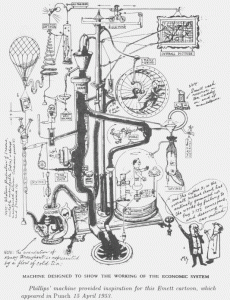I happened to be reading (as you do) an essay by Thomas Schelling in an out-of-print 1958 NBER volume, [amazon_link id=”B0006D9M14″ target=”_blank” ]A Critique of the United States Income and Product Accounts[/amazon_link]. It’s a very thought-provoking challenge to the very idea that the double (or in fact quadruple) entry system is appropriate for aggregate economic measurement. He argues that they are an elegant theoretical construct but few of the numbers have any practical interest. He suggests the drive for consistency can be counter-productive: “There is no need to impose consistency on our tables if, in fact, businessmen evaluate a significant magnitude wrongly, or just differently from the economist; both estimates are of economic significance.”
Schelling also writes: “The fact is that the real accounts do not balance, only money accounts do. I think this point is insufficiently appreciated. …[W]hat we call “real” magnitudes are not completely real; only the money magnitudes are real. The “real” ones are hypothetical.” Real values don’t follow the rules of accounting, he emphasises.
This brought to mind the illustrations in Andre Vanoli’s [amazon_link id=”1586034693″ target=”_blank” ]A History of National Accounting[/amazon_link] (another out-of-print volume – is this a theme?) of the simplified social accounting matrices set out by Richard Stone in his work in the early days of modern national accounting. Increasingly large, they have only a small proportion of cells with anything in them. The actual numbers don’t matter; the point is the logical relations between them. As Schelling says in his essay, they might just as well be asterisks or emoticons (well, he doesn’t say emoticons but they would do fine). It’s ironic that what appears to be the area of economics closest to the coal face of actual data – national accounting – is no less saturated with theoretical (‘hypothetical’) constructs than any other area of economics.

The famous Punch cartoon of the Phillips Machine still has bite
HT [amazon_link id=”0141187123″ target=”_blank” ]Susan Sontag[/amazon_link] for the title of this post
